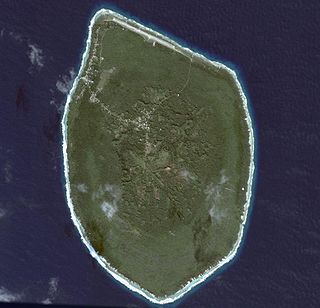Related Research Articles

The Cook Islands can be divided into two groups: the Southern Cook Islands and the Northern Cook Islands. The country is located in Oceania, in the South Pacific Ocean, about halfway between Hawaii and New Zealand.

Ātiu, also known as ʻEnuamanu, is an island of the Cook Islands archipelago, lying in the central-southern Pacific Ocean. Part of the Nga-pu-Toru, it is 214 km (133 mi) northeast of Rarotonga. The population of the 26.9 square kilometres (10.4

Mitiʻāro, the fourth island in the Cook Islands group, is of volcanic origin. Standing in water 14,750 feet (4,500 m) deep it is four miles (6.4 km) across at its widest point.

The Roman Catholic Diocese of Rarotonga in the Cook Islands is a suffragan diocese of the Roman Catholic Archdiocese of Suva in neighbouring Fiji. It was erected as the Prefecture Apostolic of Cook and Manihiki in 1922, elevated to the Vicariate Apostolic of Cook Islands in 1948 and elevated as the Diocese of Rarotonga in 1966.
Mauke Airport is an airport on Mauke in the Cook Islands.

The Cook Islands Federation was created in 1891, after the Kingdom of Rarotonga was given the island of Aitutaki. It lasted until 1901, when it was given to New Zealand.
A Tapere or Sub-District is a low level of traditional land subdivision on five of the Southern Cook Islands, comparable to the ahupua'a of the main Hawaiian Islands or to the kousapw of Pohnpei. Among the populated raised islands, only Mitiaro is not subdivided into tapere. The remaining Southern Cook Islands, Manuae, Palmerston and Takutea are atolls and/or uninhabited, and therefore not subject to this type of traditional subdivision. The atolls of the Northern Cook Islands are subdivided into motu, instead.
Ngatiarua is one of four traditional districts on the island of Mauke in the Cook islands. It is in the north of the island, between the districts of Makatea and Vaimutu, and is subdivided into five or six tapere.
Makatea is one of four traditional districts on the island of Mauke in the Cook islands. It is in the west of the island, between the districts of Areora and Ngatiarua.
Vaimutu is one of four traditional districts on the island of Mauke in the Cook islands. It is in the east of the island, between the districts of Ngatiarua and Areora.
Areora is one of four traditional districts on the island of Mauke in the Cook Islands. It is in the south of the island, and is subdivided into three tapere.
Ngaputoru is the generic name give to the islands of Atiu, Mauke, Mitiaro and Takutea in the Cook Islands archipelago. In the Cook Islands Māori language, the term means "the (nga) roots (pu) three (toru)", or in English "the three roots". Ngaputoru, which is a term used locally, refers to family ties of the ariki (chiefs) of Atiu, Mauke and Mitiaro. The island of Takutea is uninhabited. These islands are in the easternmost part of the Southern Cook Islands.
Mapu Tangatatutai Taia was a Cook Islands politician. He served as Speaker of the Cook Islands Parliament from 2006 to 2010. He was a member of the Cook Islands Democratic Party and held the traditional title of Kakemaunga Mataiapo.
Tutai Tura is a Cook Islands politician and former member of the Cook Islands Parliament. Since March 2021 he has been Speaker of the Cook Islands Parliament. He is a member of the Cook Islands Party.

Mauke is an island of the Cook Islands archipelago, lying in the central-southern Pacific Ocean. Part of the Nga-pu-Toru, it is 277 km (172 mi) northeast of Rarotonga.

Renewable energy in the Cook Islands is primarily provided by solar energy and biomass. Since 2011 the Cook Islands has embarked on a programme of renewable energy development to improve its energy security and reduce greenhouse gas emissions, with an initial goal of reaching 50% renewable electricity by 2015, and 100% by 2020. The programme has been assisted by the governments of Japan, Australia, and New Zealand, and the Asian Development Bank.
Vai Tango Cave is a karst cave located a short distance from Ngatiarua Village, on the island of Mauke in the Cook Islands. The cave is a cenote cave with overhanging stalactites and a deep pool used for swimming. The pool extends more than 100m back and 50m across.

Arago hotspot is a hotspot in the Pacific Ocean, presently located below the Arago seamount close to the island of Rurutu, French Polynesia.
Tararo Jane Ariki II was a Cook Islands chiefess and politician. An ariki of Mauke island, she was also the first woman to become a member of the islands' Legislative Council.
Oiretumu is a village on Mauke in the Cook Islands. The village is inland, near the centre of the island.
References
- ↑ Kloosterman, Alphons M. J. (1976). "Discoverers Of The Cook Islands And The Names They Gave". Cook Islands Library and Museum. pp. 24–26. Retrieved 22 August 2020– via NZETC.
20°8′39.41″S157°21′22.7″W / 20.1442806°S 157.356306°W